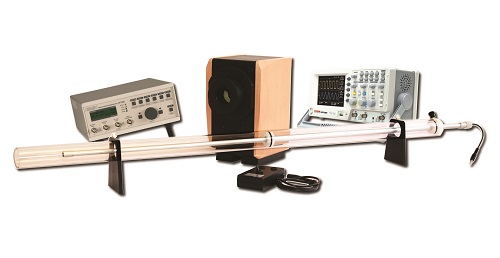Standing sound waves: EXP100090 or EXP100091
Référence : EXP 100 090

A standing wave is the phenomenon resulting from the addition of at least two waves, of identical frequency, propagated in the same medium in different directions. This wave is characterised by time invariant elements (wavelength, antinode, node, speed. The Kundt tube is used to observe a standing wave. A loudspeaker coupled to a function generator generates waves of varying frequencies. A micro equipped with an amplifier observes waveform at various points of the tube, thus identifying by measurement the maximum (probe on an antinode) and minimum (probe on a node) pressure values of the standing wave. The observed signal is visible on the oscilloscope.
STANDING SOUND WAVES
The Kundt tube principle is as follows: a tube is closed at one end by a “micro-holder”, made up of an absorbing material
(homogeneous, isotropic). It is also cylindrical and of finished thickness e. At the other end, a loudspeaker supplied by a LF generator emits a pure frequency sound wave (incident wave) that is reflected by the micro-holder. As it crosses the tube, the wave loses amplitude (energy transformation by absorption). Moreover, the reflected wave is phase-shifted (due to lag) with the incident wave. The reflected and incident waves meet to form a standing wave. The micro and its amplifier then allow us to observe easily the complete waveform.
MATERIAL ABSORPTION
The Kundt tube principle is as follows: a tube is closed at one end by a “micro-holder”, made up of an absorbing material
(homogeneous, isotropic). It is also cylindrical and of finished thickness e. At the other end, a loudspeaker supplied by a LF generator emits a pure frequency sound wave (incident wave) that is reflected by the micro-holder. As it crosses the tube, the wave loses amplitude (energy transformation by absorption). Moreover, the reflected wave is phase-shifted (due to lag) with the incident wave. The reflected and incident waves meet to form a standing wave. The micro and its amplifier then allow us to observe easily the complete waveform.
SUBJECTS APPROACHED
»»Material absorption
»»Standing sound waves
NECESSARY EQUIPMENT
COMPOSITION
EXP100091 Standing sound waves (BASIC)
| Reference | Description | quantity | | PHD015602 | Kundt's tube | 1 | | PHD015613 | Amplifier | 1 |
COMPOSITION
EXP100090 Standing sound waves (COMPLETE)
| Reference | Description | quantity | | PHD015602 | Kundt's tube | 1 | | PHD015613 | Amplifier | 1 | | EMD018015 | Digital oscilloscope, 2x100 MHz | 1 | | PMM062685 | Function generator, 5 MHz, with amplifier | 1 | | PEM010021 | BNC cord | 1 | | PED080100 | Set of 2 cords, 1 m (1 red/ 1 black) | 2 | | PED063700 | Adapter BNC/2xØ 4-mm sockets | 1 |
|
|



